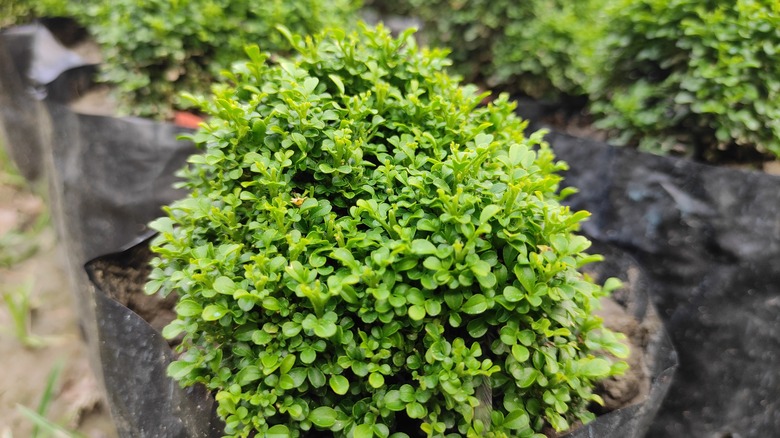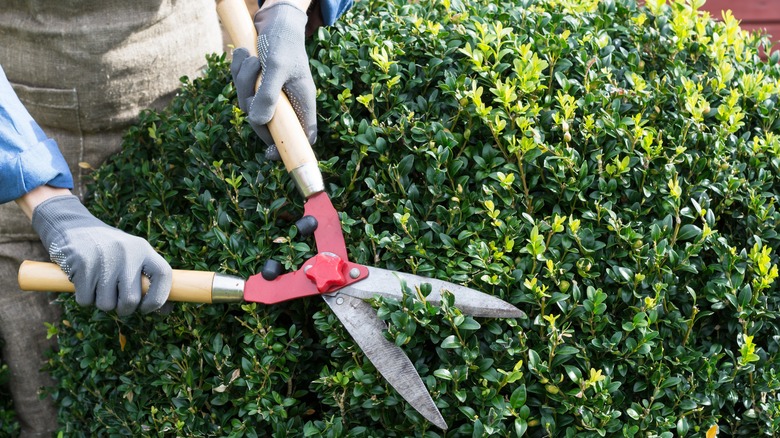The Popular Evergreen Shrub That Is Perfect For Plant Sculpting (& How To Do It)
There are many savvy ways to incorporate art into your yard – and your plants can be one of them! Plants come in all shapes and sizes and can even be sculpted into a living piece of artwork. House Digest spoke exclusively with Jennifar McComish, Senior Live Goods Merchant at The Home Depot, to learn more about boxwood — the popular evergreen shrub perfect for plant sculpting.
According to McComish, plant sculpting, also known as a topiary, is "the art of training and pruning dense leaved shrubs into [three-dimensional] objects in the landscape or in containers." Because the boxwood shrub grows in many varieties, this plant is great for sculpting. "Varieties differ by cold tolerance, growth habits and shades of green," McComish explained. "There are new varieties that have been bred for disease resistance such as Better Boxwood which is resistant to boxwood blight. Green Mountain Boxwoods are upright slow growing boxwoods with intense green foliage that make a perfect choice for creating spiral topiaries." McComish added that the Winter Gem variety for growing in cooler regions and the Japanese Boxwood for growing in warmer regions can be shaped into hedges, or box and ball topiaries. With all of the different boxwood varieties available, the sculpting possibilities seem endless.
How to choose the right plant for sculpting
When heading to a garden center or nursery, choosing the right plant can sometimes pose a challenge to gardeners. Luckily, McComish spoke exclusively with House Digest about how to make your boxwood plant selection when planning on using it for sculpting. "Select a shrub with a dense foliage, which is easier to shape and maintain. Certain boxwood varieties naturally grow in specific habits such as more upright, or compact," McComish shared. "Choose varieties that will grow in your climate. Boxwoods have been bred to thrive in specific conditions. Be sure to research which varieties will grow the best in your region of the country."
You may even want to choose a species other than boxwood, depending on how you plan to design your garden. According to McComish, boxwoods are "favored for its dense foliage and slow growth, making it ideal for detailed shaping," while privets are an "upright growing plant often utilized for hedge screening, spiraling and [two to three] ball topiaries." Juniper, cherry laurel, and ficus plants are also all good choices for plant sculpting. Deciding on your garden goals and learning more about the plant's needs will help you make the right decision for your garden. If you do choose boxwood, you'll also need to learn how to care for it.
How to shape your boxwood shrub
Shaping your boxwood into a plant sculpture will take time, but the results will be well worth your effort. According to McComish's exclusive interview with House Digest, "Pruning and shaping a boxwood into a plant sculpture or topiary involves several steps. Depending on your final sculpture shape goal, utilize varieties that naturally grow more upright, spreading, or more compact which will require less pruning to achieve and maintain the final desired shape." When pruning your shrub, "utilize sharp hand pruners, hand hedging shears or mechanical hedging shears. Be sure to sterilize the pruners between plant species as to not spread diseases between plants."
Wire can also be a helpful tool to shape the plant. McComish said, "Use bonsai wire to gently bend and position branches into the desired shape. Wrap the wire carefully around the branches to guide their growth without causing damage." McComish recommends the OOK 50-foot 10-pound 18-Gauge Aluminum Hobby Wire at The Home Depot, which is "easy to dispense and can be easily cut with a pair of pliers." Love your outdoor topiaries? You can grow an indoor topiary too!


